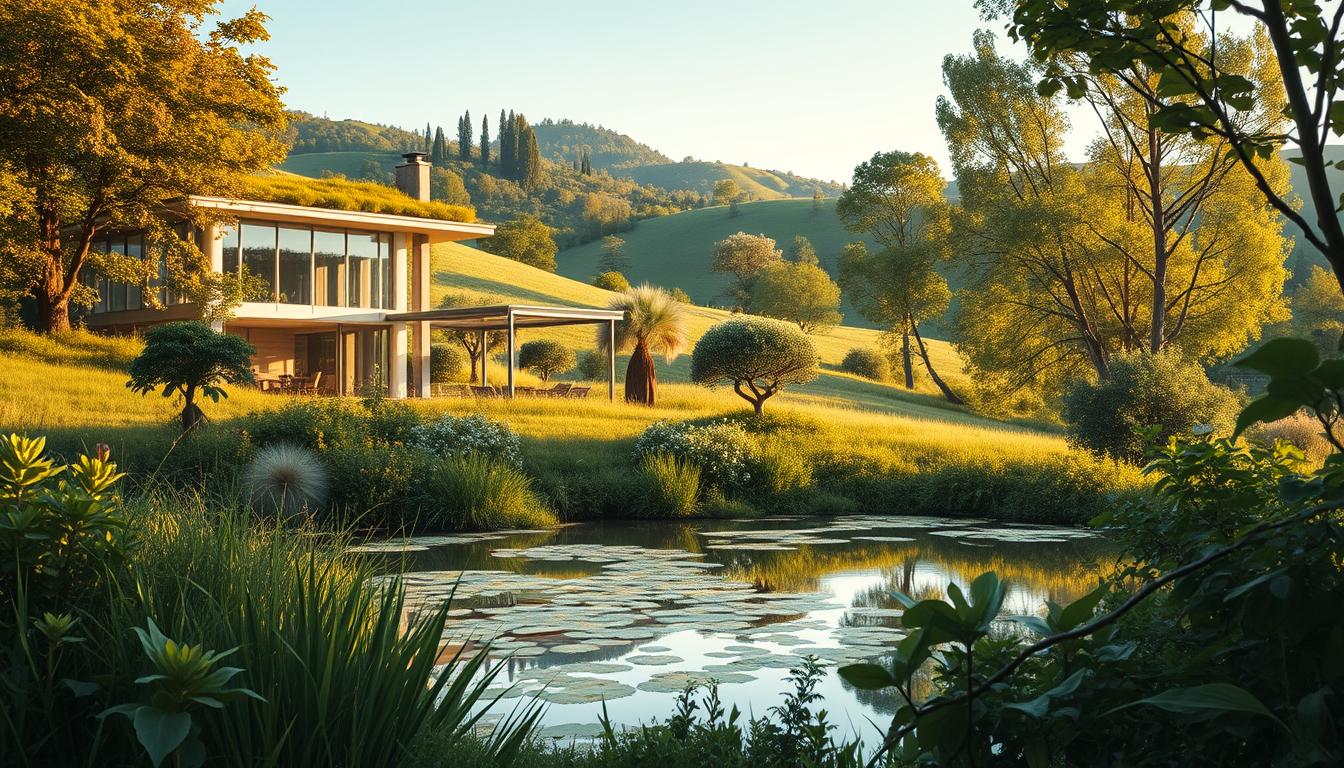In an era where environmental consciousness is not just valued but essential, we’re witnessing a significant shift in the way we approach home sustainable design. The field of design is evolving, driven by our collective realization of the impact our choices have on the planet.
As we move towards a more sustainable future, eco-friendly home designs have transformed from being mere trends to essential elements of modern living spaces. At CoWrit Technologies Inc, we recognize the importance of balancing aesthetics, functionality, and environmental responsibility in home design.
We’re committed to supporting homeowners in implementing innovative design solutions that not only reduce environmental impact but also create healthier living environments. Through our comprehensive services, including AI Generative Applications Prompt Engineering and Content Writings, we help transform ordinary homes into sustainable sanctuaries.
Key Takeaways
- Understanding the evolution of eco-friendly home designs and their growing importance.
- Exploring the comprehensive approach to sustainable home design.
- Discovering innovative design solutions for healthier living environments.
- Learning about the role of sustainable materials and energy-efficient solutions.
- Previewing the various aspects of eco-friendly home design covered in this article.
The Rise of Sustainable Home Design
The world is witnessing a significant shift towards sustainable home design, driven by the need to reduce environmental impact. As we become more aware of the planet’s limitations, the design industry is adapting to prioritize sustainability and energy efficiency.
Environmental Consciousness in Modern Living
Growing environmental consciousness has influenced homeowners’ preferences, with many prioritizing eco-friendly designs that minimize their carbon footprint. This shift is not just about reducing environmental impact; it’s also about creating healthier living spaces.
| Benefits | Description |
|---|---|
| Reduced Environmental Impact | Eco-friendly designs minimize harm to the planet. |
| Lower Utility Costs | Sustainable designs often reduce energy consumption. |
| Improved Health Outcomes | Healthier living spaces improve occupants’ well-being. |
Benefits of Adopting Eco-Friendly Home Designs
Adopting eco-friendly home designs not only contributes to global environmental goals but also creates more comfortable and efficient living spaces. As we move forward, it’s clear that sustainable design is not just a trend, but a necessary approach to building a better future for our world.
Understanding Eco-Friendly and Innovative Designs
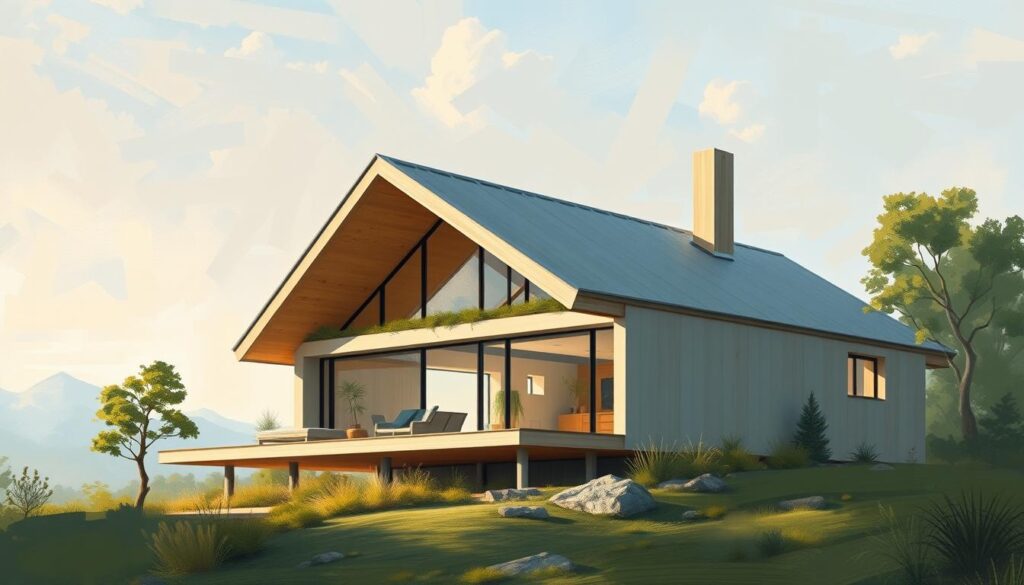
Understanding eco-friendly and innovative designs requires a look into the principles that guide sustainable home design, balancing form and function with environmental stewardship. Sustainable design challenges the notion that beauty and functionality are separate from environmental responsibility.
Key Principles of Sustainable Home Design
The core principles of eco-friendly home design include a lifecycle approach, considering the environmental impact of materials and products from production through disposal. This approach ensures that each element contributes to the overall sustainability and reduces resource use.
Balancing Aesthetics with Environmental Responsibility
Designers are reimagining traditional home elements to reduce resource use while enhancing living experiences. By integrating environmental responsibility with aesthetic appeal and practical functionality, sustainable design creates compelling, innovative works that safeguard our planet.
Sustainable Building Materials for Your Home
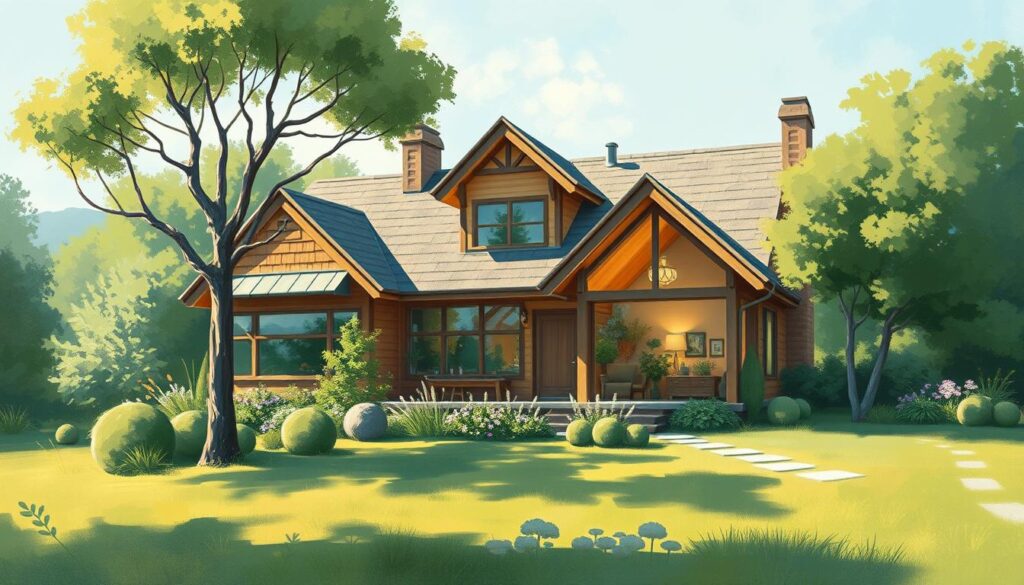
As we continue to explore eco-friendly home designs, the importance of sustainable building materials cannot be overstated. The use of renewable, recycled, or low-impact materials means less harm to the environment.
Bamboo and Cork: Renewable Alternatives to Hardwood
Bamboo and cork are excellent alternatives to traditional wood. They help conserve forests and offer durability and versatility. Bamboo, for instance, is highly renewable due to its fast growth rate.
Recycled Metals and Plastics
Using recycled metals and plastics in home construction reduces waste and the carbon footprint associated with production. These materials are transformed into beautiful and functional home elements.
Innovative Bio-Based Materials
New material innovations, such as mycelium composites and plant-based alternatives, are pushing the boundaries of sustainable design. These bio-based materials promote recycling and reduce environmental impact.
Energy-Efficient Home Design Solutions

The key to a sustainable future lies in innovative energy-efficient home design. By incorporating cutting-edge technologies and sustainable practices, homeowners can significantly reduce their energy consumption while enhancing the comfort and livability of their homes.
Passive Solar Design Strategies
Passive solar design leverages natural elements like sunlight, shade, and thermal mass to maintain comfortable temperatures with minimal energy use. This approach involves careful planning and orientation of the home to maximize natural lighting and heat.
Smart Home Technology for Energy Conservation
Smart home technology is revolutionizing energy conservation through automated systems that optimize heating, cooling, lighting, and appliance operation. These systems can be controlled remotely, providing homeowners with greater flexibility and control over their energy consumption.
Renewable Energy Integration
Renewable energy integration is a critical component of energy-efficient home design. By incorporating energy-generating technologies like solar panels and small-scale wind systems, homeowners can reduce their reliance on non-renewable energy sources and lower their carbon footprint.
By combining these energy-efficient design solutions, homeowners can create a comprehensive system that maximizes efficiency and minimizes environmental impact. For example, a well-designed home might incorporate passive solar design strategies, smart home technology, and renewable energy integration to achieve a net-zero energy status.
Water Conservation Design Elements
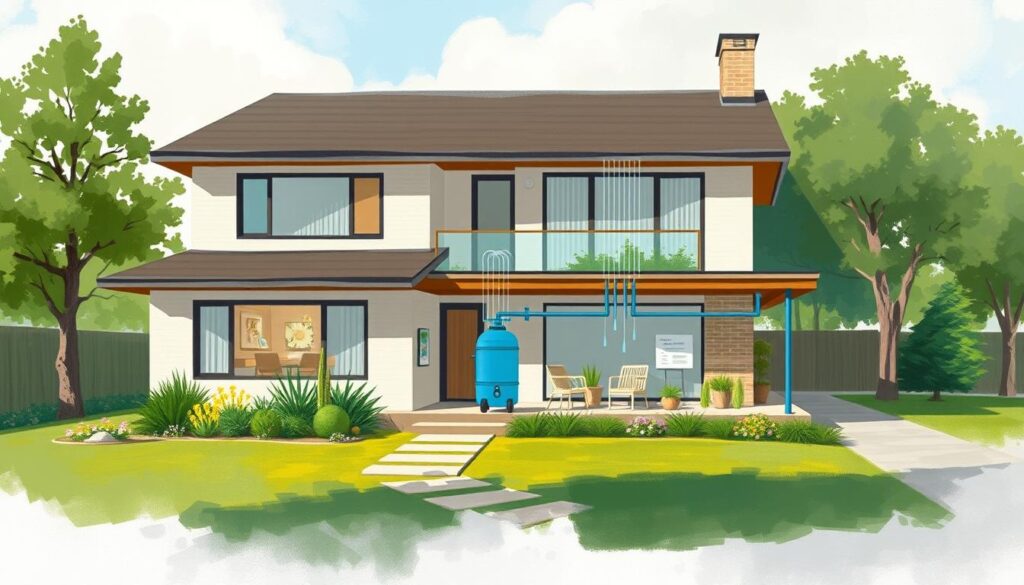
Innovative water-saving solutions are transforming the way we design our homes. We’re exploring various design elements that not only reduce water consumption but also maintain the functionality and convenience expected in modern living.
Rainwater Harvesting Systems
Rainwater harvesting systems collect and store precipitation for various non-potable uses such as landscape irrigation and toilet flushing. This approach significantly reduces the demand on municipal water supplies.
Greywater Recycling Solutions
Greywater recycling solutions capture, treat, and reuse water from showers, bathroom sinks, and washing machines. This process significantly reduces overall water consumption, making it a valuable component of water conservation strategies.
Water-Efficient Fixtures and Appliances
The latest water-efficient fixtures and appliances use a fraction of the resources required by conventional models, delivering excellent performance while conserving water. For example, low-flow showerheads and toilets are now designed to provide the same user experience while using less water.
By integrating these water conservation elements, homeowners can create a comprehensive approach to responsible water management. As an example, combining rainwater harvesting with greywater recycling and water-efficient fixtures can significantly reduce a home’s water footprint.
Waste-Reducing Home Design Concepts
In the quest for eco-friendly living, minimizing waste through thoughtful design is a key strategy. We explore innovative approaches that not only reduce environmental impact but also enhance the aesthetic appeal of our homes.
By employing methodologies that decrease the amount of waste produced, both in the manufacturing process and throughout the life of the product, we can significantly minimize our environmental footprint.
Composting Systems for Kitchen Waste
Composting is a simple yet effective way to reduce kitchen waste. By integrating composting systems into our homes, we can transform food scraps into valuable garden resources. This not only reduces landfill contributions but also creates a nutrient-rich soil amendment for our gardens, promoting healthier plant growth and reducing the need for synthetic fertilizers.
Upcycled Furniture and Decor
Upcycling gives new life to existing materials, combining sustainability with unique aesthetic appeal. We can create beautiful and functional pieces from materials that would otherwise end up in landfills, thus reducing the demand for new raw materials and the waste associated with their processing.
Design for Disassembly and Recyclability
Designing products and building elements with their end-of-life process in mind is crucial for minimizing waste. This approach ensures that materials can be easily recycled or reused, supporting a circular economy and reducing the environmental impacts associated with raw material extraction and processing.
By adopting these waste-reducing design concepts and incorporating effective recycling practices, we contribute to a more circular approach to home living, where materials maintain their value through multiple life cycles.
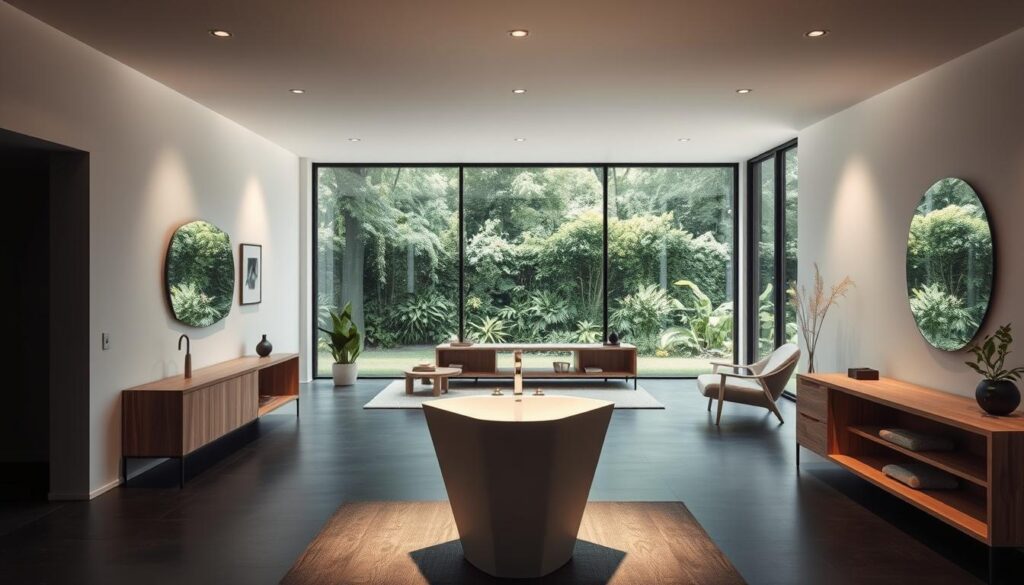
- Composting systems reduce kitchen waste and create garden resources.
- Upcycled furniture and decor give new life to existing materials.
- Design for disassembly and recyclability supports a circular economy.
Innovative Indoor Air Quality Improvements
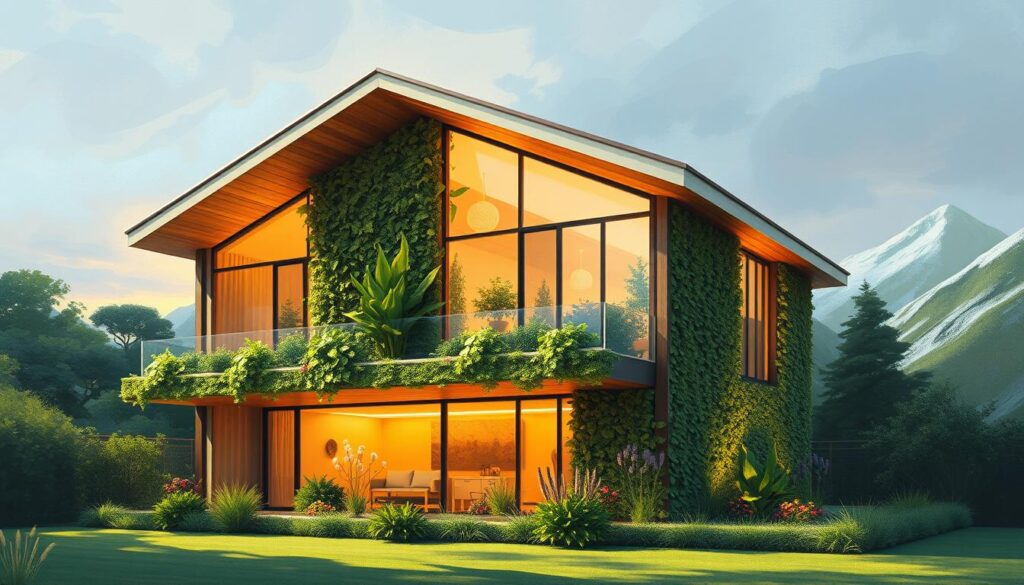
As we strive to make our homes more sustainable, indoor air quality has become a significant focus. We explore innovative approaches to improving indoor air quality that create healthier living environments while reducing environmental impact.
Natural Ventilation Systems
Natural ventilation systems maximize air circulation and exchange without relying on energy-intensive mechanical solutions. These systems utilize operable windows, skylights, and passive stack ventilation to enhance indoor air quality.
Living Walls and Indoor Plants
Living walls and strategically placed indoor plants serve as both beautiful design elements and natural air purifiers. They help remove pollutants and improve the overall indoor environment.
Non-Toxic Materials and Finishes
Selecting non-toxic materials and finishes is crucial for protecting occupant health and environmental quality. We discuss the importance of choosing materials that don’t off-gas harmful chemicals, thereby enhancing indoor air quality.
Eco-Friendly Kitchen Design Ideas
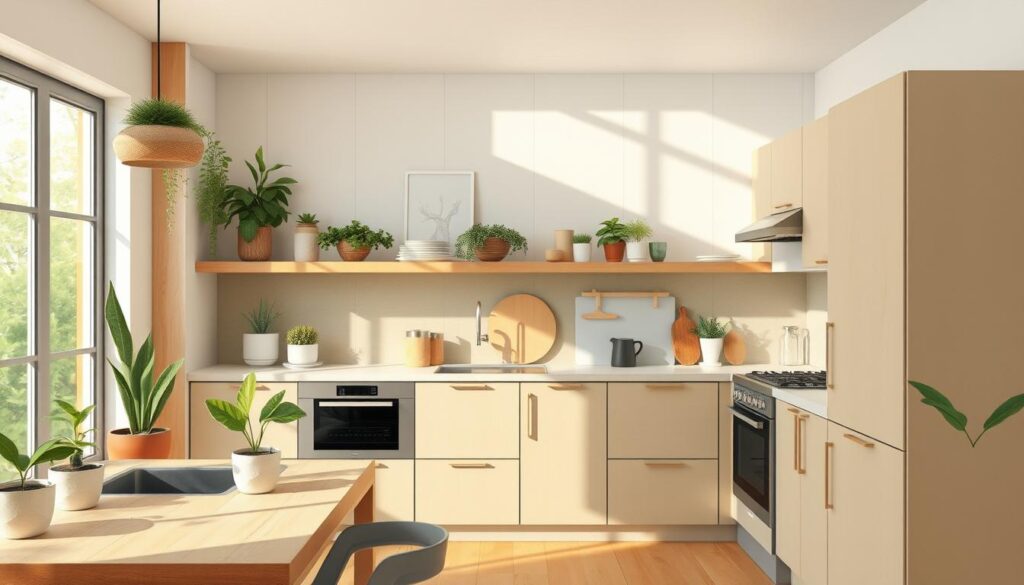
Sustainable living starts in the kitchen, and we’re here to guide you through the process. Eco-friendly kitchen design is not just about aesthetics; it’s about creating a space that reduces energy consumption and waste while promoting a healthier lifestyle.
Sustainable Countertop Options
Choosing the right countertop material can significantly reduce your kitchen’s environmental footprint. Consider countertops made from recycled materials or rapidly renewable resources like bamboo.
Energy-Efficient Appliances
Upgrading to energy-efficient appliances is a straightforward way to lower your kitchen’s carbon footprint. Look for products with high Energy Star ratings for optimal performance and reduced energy use.
Zero-Waste Kitchen Organization
Implementing a zero-waste kitchen organization system can make a significant difference. This includes using recyclable materials for storage and optimizing your kitchen layout to minimize waste and improve workflow.
Sustainable Bathroom Innovations
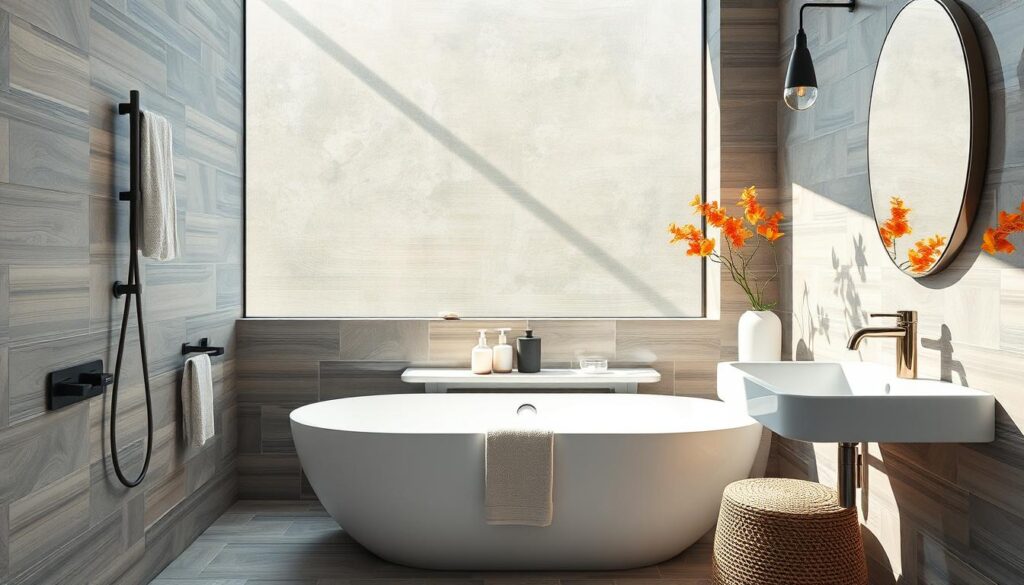
The quest for a greener bathroom is being answered with innovative designs and technologies that reduce waste and conserve resources. We are seeing a significant shift towards sustainability in bathroom design, driven by the need to minimize environmental impact while maintaining luxury and functionality.
Water-Saving Fixtures
One of the most effective ways to make your bathroom more sustainable is by installing water-saving fixtures. Low-flow toilets, aerated faucets, and thermostatic shower systems are designed to maintain performance while dramatically reducing water consumption.
Eco-Friendly Tile and Surface Materials
The choice of materials for your bathroom can significantly affect its environmental footprint. Eco-friendly options include tiles made from recycled glass, reclaimed wood, and natural stone. These material choices not only reduce waste but also add a unique aesthetic to your bathroom.
Natural Lighting Solutions
Maximizing energy efficiency in your bathroom can be achieved through the use of natural lighting solutions. Skylights, light tubes, and strategically placed windows can reduce the need for artificial lighting, enhancing the quality and ambiance of the space.
Smart and Sustainable Outdoor Living Spaces
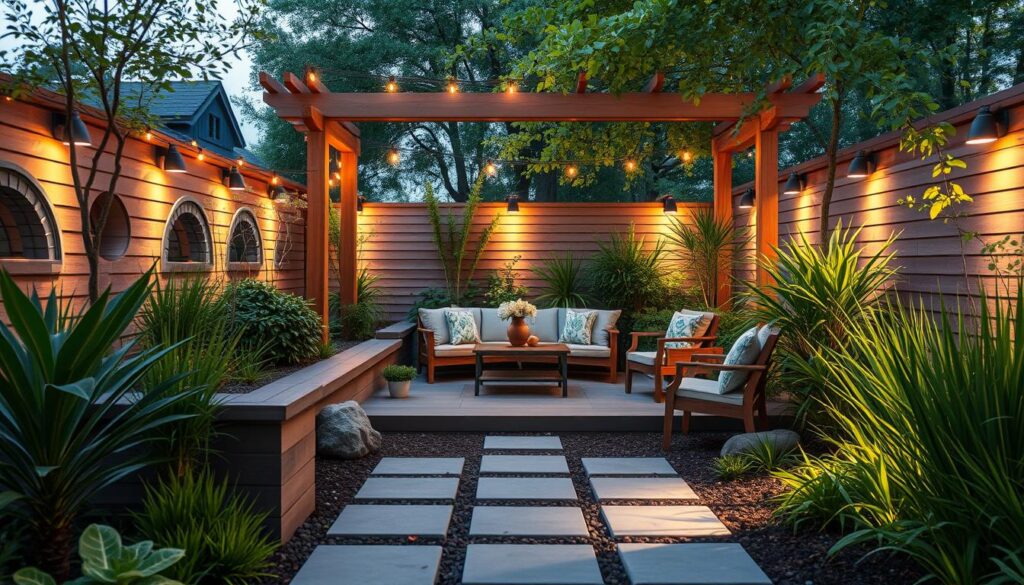
Sustainable landscape design is not just about aesthetics; it’s about creating outdoor spaces that minimize environmental impact while maximizing enjoyment. At its core, sustainable design seeks to utilize resources thoughtfully and efficiently.
Native Plant Landscaping
Native plant landscaping is a key element of sustainable outdoor design. By using plants native to the region, we can reduce water consumption and support local wildlife, creating resilient gardens that thrive with minimal maintenance.
Permeable Paving Options
Permeable paving options for driveways, walkways, and patios manage stormwater naturally, reducing runoff and helping to replenish groundwater. This approach not only reduces the environmental impact but also enhances the aesthetic appeal of the outdoor space.
Solar-Powered Outdoor Lighting
Solar-powered outdoor lighting systems provide safety and ambiance without increasing carbon footprint or energy costs. By harnessing the power of the sun, we can create inviting outdoor spaces that are both eco-friendly and enjoyable.
By incorporating these sustainable design elements, we can create outdoor living spaces that are not only environmentally responsible but also deeply enjoyable for everyday living. For example, rain gardens, food production spaces, and outdoor rooms created with reclaimed wood and recycled materials are just a few practical examples of sustainable outdoor design projects.
Conclusion: Embracing a Greener Future with CoWrit Technologies Inc
Embracing a greener future starts with the choices we make in our homes, from the materials we use to the energy we consume. We’ve explored how sustainable design practices have evolved, transforming the way we approach residential architecture today.
At CoWrit Technologies Inc, we support your sustainable design journey through comprehensive services like AI Generative Applications and Content Writing. Reach out to us via WhatsApp Call & Chat: +44-7822010953 to make informed choices for your eco-friendly home design projects.
